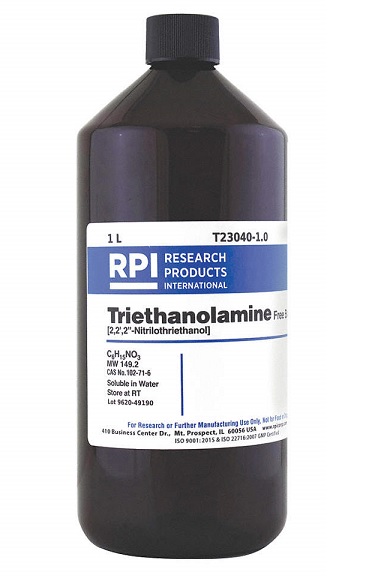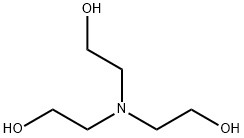-
外観
無色~わずかにうすい黄色, 澄明の液体
-
性質
トリエタノールアミンの主な性質は、塩基性であることです。0.1N濃度の水溶液のpHが約10.5です。融点 (凝固点) は約20℃であり、沸点は約340℃です。トリエタノールアミンは、上記の通りさまざまな用途で使用できる有用な化合物ですが、その反面で安全性の点では注意を要する化合物です。
トリエタノールアミンを吸入すると、呼吸器に刺激を与えます。 長期的に経口摂取したり肌に接触し続けると、人体に障害を引き起こす可能性があります。特に注意を要するのは、トリエタノールアミンの希釈水溶液が霧状になった場合です。
含有濃度が低くても、霧状となった水溶液を吸い込んだり目に入れたりすると、粘膜が刺激されるため有害です。また、トリエタノールアミンの安全性に関して特に発がん性については日本国内だけでなく、国際的に調査されています。
発がん性に関しては、「IARC 77 (2000) でグループ3」に分類されています。トリエタノールアミンに発がん性があることが明確に証明されたわけではありませんが、発がん性を有さないと断言できる状況でもありません。
-
定義
TEAは、トリエタノールアミンの表示名称である。本品は、次の化学式で表されるアルカノールアミンである。
-
溶解性
水及びエタノールに極めて溶けやすい。
-
用途
トリエタノールアミンは,エンジンの冷却剤および清浄剤,界面活性剤,セメント分散剤などに用いられる。また強アルカリ性溶液中で,3価の金属イオン (鉄,マンガン,アルミニウムなど) と安定なキレート化合物をつくるので,これらのマスキング剤としても用いられる。
-
解説
2,2′,2″-nitrilotriethanol.C6H15NO3(149.19).N(CH2CH2OH)3.化学式 (HOCH2CH2)3N 。トリエタノールアミンは,アンモニア様の臭気をもつ。水より少し粘稠で重い。吸湿性である。エチルアルコール,水に溶け,エーテルには溶けない。塩基とアルコールの両性質を有する。アンモニア水中に過剰のエチレンオキシドを常温で加えると得られる.融点21.2 ℃,沸点360 ℃.d2020 1.258.n20D 1.4852.pKa 7.82(25 ℃).水,アルコール類,アセトンに可溶,エーテル,ベンゼンなど非極性溶媒に難溶.塩基触媒として有機合成反応に使用されるほか,乳化剤,可塑剤,保湿剤などに使用される.多くの金属と錯体をつくる.森北出版「化学辞典(第2版)
-
用途
界面活性剤原料、セメント添加剤
-
構造
トリエタノールアミンの分子構造は、窒素原子 (N) に3つのエタノールが結合したような構造です。Nに3つの炭素 (C) が結合した第三級アミンですが、ヒドロキシ基が3つあるため水溶性が高いという性質を有します。(HOCH2CH2)3N で表すことができます。
トリエタノールアミンは、分子中に3つのヒドロキシ基 (-OH) を有するため、水中でキレート作用を発揮できます。よって、トリエタノールアミンを水中に微量添加することで、水中に存在する金属イオンを安定化させてキレートの状態へ変えられます。
-
化粧品の成分用途
pH調整剤、乳化剤、香料
-
効能
アルカリ化剤
-
使用上の注意
粘性のある吸湿性の澄明の液体で、二酸化炭素を吸収する。
-
説明
Triethanolamine is a viscous, colourless/pale yellow liquid with a weak ammoniacal odour. Triethanolamine is incompatible with copper, copper alloys, galvanised iron, acids, and oxidisers. Reports indicate that in India itself, as many as six companies manufacture triethanolamine and it is manufactured by many different countries around the world. Global production and industrial application of triethanolamine is very extensive.

In industries, triethanolamine is used as a corrosion inhibitor in metal-cutting fluids; a curing agent for epoxy and rubber polymers; a copper–triethanolamine; in emulsifiers, thickeners, and wetting agents in the formulation of consumer products such as cosmetics, detergents, shampoos, and other personal products; and a neutraliser-dispersing agent in agricultural herbicide formulations. In brief, triethanolamine has wide applications as a corrosion inhibitor, a surface-active agent, and an intermediate in various products including metalworking fluids, oils, fuels, paints, inks, cement, cosmetic, and personal products and formulations of algicides and herbicides.
-
化学的特性
Triethanolamine is a pale yellow and viscous liquid. It is hygroscopic with an irritant and ammoniacal odor. There are multiple industrial and domestic applications for this compound, i.e., in the manufacture of toilet products, cosmetics formulations, solvents for waxes, resins, dyes, paraffi ns and polishes, herbicides, and lubricants for textile products. In the pharmaceutical industry, triethanolamine is used as a non-steroidal, antiinfl ammatory agent, an emulsifi er, and an alkylating agent.
-
使用
Triethanolamine is used primarily as a surfactant, reducing the surface tension between two media. It is also used as a general emulsifier for preparations, such as ones involving drug penetration ass
ays.
-
定義
ChEBI: Triethanolamine is a tertiary amino compound that is ammonia in which each of the hydrogens is substituted by a 2-hydroxyethyl group. It has a role as a buffer and a surfactant. It is a tertiary amino compound, a triol and an amino alcohol. It is functionally related to a triethylamine. It is a conjugate base of a triethanolammonium.
-
製造方法
Triethanolamine is prepared commercially by the ammonolysis of ethylene oxide. The reaction yields a mixture of monoethanolamine, diethanolamine, and triethanolamine, which are separated to obtain the pure products.
-
調製方法
Triethanolamine is produced with ethanolamine and diethanolamine by ammonolysis
of ethylene oxide and the triethanolamine is then separated by distillation
(Mullins 1978). In 1984, 139.6 million pounds of triethanolamine were produced
in the United States (USTIC 1985).
-
世界保健機関(WHO)
Trolamine is widely used as an emulsifier in combination with
fatty acids in pharmaceutical and cosmetic products. The World Health Organization is not aware of restrictive action having been taken elsewhere.
-
一般的な説明
Oily liquid with a mild ammonia odor. Denser than water. Freezing point is 71°F.
-
空気と水の反応
Water soluble.
-
反応プロフィール
Triethanolamine is an aminoalcohol. Neutralize acids to form salts plus water in exothermic reactions. Amines may be incompatible with isocyanates, halogenated organics, peroxides, phenols (acidic), epoxides, anhydrides, and acid halides. Flammable gaseous hydrogen is generated in combination with strong reducing agents, such as hydrides. Reacts violently with strong oxidants. [Handling Chemicals Safely 1980. p. 928].
-
健康ハザード
Exposures to triethanolamine, in contrast with other chemical compounds, is known to cause low toxicity to animals and the acute oral LD50 to rats and guinea pigs ranges from 8000 to 9000 mg/kg. Triethanolamine was found to be a moderate eye irritant. A 5%–10% solution of triethanolamine did not induce skin irritation or skin sensitization. Studies of Inoue et al. and many other workers have indicated the absence of the mutagenic potential of triethanolamine as evidenced by both in vivo and in vitro studies (Salmonella typhimurium tests, Chinese hamster ovary cells, and rat liver chromosome analysis). Further, extensive studies have demonstrated the absence of potential carcinogenicity of triethanolamine in rats and mice, suggesting a low or lack of acute or chronic toxicity of the chemical to mammals.
-
火災危険
Special Hazards of Combustion Products: Poisonous gases, such as NOx, may be produced
-
法規情報
化学兵器への利用を防ぐ目的で、トリエタノールアミンは化学兵器禁止条約の「Schedule 3, part B」リストに掲載されています。また、化学兵器の禁止及び特定物質の規制等に関する法律に基づいて、「第二種指定物質」として指定されています。
参考文献
-
使用用途
トリエタノールアミンの使用用途として、有機合成反応における塩基触媒の用途が挙げられます。その他、界面活性剤の補助剤として合成洗剤に配合されます。電子材料の洗浄剤や金属腐食防止剤、セメント添加剤、農薬原料、ポリウレタン発泡剤、不凍液添加剤、防錆剤、切削剤などのも用途の1つです。
トリエタノールアミンの身近な使用例としては、pH調整または乳化補助の目的で、シャンプーやリンス、ボディーソープなどに配合されます。乳液やローションなどの基礎化粧料、口紅やアイシャドーなどのメイクアップ化粧料に使用される場合があります。
さらに、溶解補助剤の目的で静脈内注射に配合されたり、医薬品添加剤として外用剤に配合されたりします。
-
化学反応性
Reactivity with Water No reaction; Reactivity with Common Materials: No reactions; Stability During Transport: Stable; Neutralizing Agents for Acids and Caustics: Dilute with water; Polymerization: Not pertinent; Inhibitor of Polymerization: Not pertinent.
-
応用例(製薬)
Triethanolamine is widely used in topical pharmaceutical formulations,
primarily in the formation of emulsions.
When mixed in equimolar proportions with a fatty acid, such as
stearic acid or oleic acid, triethanolamine forms an anionic soap
with a pH of about 8, which may be used as an emulsifying agent to
produce fine-grained, stable oil-in-water emulsions. Concentrations
that are typically used for emulsification are 2–4% v/v of
triethanolamine and 2–5 times that of fatty acids. In the case of
mineral oils, 5% v/v of triethanolamine will be needed, with an
appropriate increase in the amount of fatty acid used. Preparations
that contain triethanolamine soaps tend to darken on storage.
However, discoloration may be reduced by avoiding exposure to
light and contact with metals and metal ions.
Triethanolamine is also used in salt formation for injectable
solutions and in topical analgesic preparations. It is also used in sun
screen preparations.
Triethanolamine is used as an intermediate in the manufacturing
of surfactants, textile specialties, waxes, polishes, herbicides,
petroleum demulsifiers, toilet goods, cement additives, and cutting
oils. Triethanolamine is also claimed to be used for the production
of lubricants for the rubber gloves and textile industries. Other
general uses are as buffers, solvents, and polymer plasticizers, and as
a humectant.
-
接触アレルゲン
This emulsifying agent can be contained in many products
such as cosmetics, topical medicines, metalworking cut-
ting fluids, and color film developers. Traces may exist in
other ethanolamines such as monoand diethanolamine.
Contact allergy seems to be rarer than previously thought.
-
安全性プロファイル
Moderately toxic by
intraperitoneal route. Mildly toxic by
ingestion. Liver and kidney damage have
been demonstrated in animals from chronic
exposure. A human and experimental skin
irritant. An eye irritant. Questionable
carcinogen with experimental carcinogenic
data. Combustible liquid when exposed to
heat or flame; can react vigorously with
oxidizing materials. To fight fire, use alcohol
foam, CO2, dry chemical. When heated to
decomposition it emits toxic fumes of NOx
and CN-.
-
安全性
Triethanolamine is used primarily as an emulsifying agent in a
variety of topical pharmaceutical preparations. Although generally
regarded as a nontoxic material, triethanolamine may cause
hypersensitivity or be irritant to the skin when present in formulated
products. The lethal human oral dose of triethanolamine is
estimated to be 5–15 g/kg body-weight.
Following concern about the possible production of nitrosamines
in the stomach, the Swiss authorities have restricted the use of
triethanolamine to preparations intended for external use.
LD50 (guinea pig, oral): 5.3 g/kg
LD50 (mouse, IP): 1.45 g/kg
LD50 (mouse, oral): 7.4 g/kg
LD50 (rat, oral): 8 g/kg
-
職業ばく露
Monoethanolamine is widely used in
industry for scrubbing acid gases and in production of
detergents and alkanolamide surfactants; to remove carbon dioxide and hydrogen from natural gas, to remove hydrogen
sulfide and carbonyl sulfide; as an alkaline conditioning
agent; as an intermediate for soaps, detergents, dyes, and
textile agents. Diethanolamine is an absorbent for gases; a
solubilizer for 2,4- dichlorophenoxyacetic acid (2,4-D); and
a softener and emulsifier intermediate for detergents. It also
finds use in the dye and textile industry. Triethanolamine is
used as plasticizers, neutralizer for alkaline dispersions;
lubricant additive; corrosion inhibitor; and in the manufacture of soaps, detergents, shampoos, shaving preparations;
face and hand creams; cements, cutting oils, insecticides,
surface active agents; waxes, polishes, and herbicides.
-
発がん性
Results of carcinogenicity
studies have been controversial. Hoshino and Tanooka reported that triethanolamine in the diet of mice at levels
of 0.03% or 0.3% caused a significant increase in the
occurrence of tumors, both benign and malignant. Females
showed a 32% increase, mostly of thymic lymphomas. The
increase of all other tumors, in both sexes, was 8.2%. They
also found that triethanolamine reacted with sodium nitrite
to produce N-nitrosodiethanolamine and that the product
caused mutagenesis in bacteria. Maekawa et al.
reported that no carcinogenic activity was found when
given orally to rats in drinking water at concentrations of
1% and 2% for 2 years. However, the dosage to
females was halved after week 69 of treatment owing to
nephrotoxicity. Histological examination of renal damage
in treated animals revealed acceleration of chronic
nephropathy, mineralization of the renal papilla, nodular
hyperplasia of the pelvic mucosa, and pyelonephritis with
or without papillary necrosis. Nephrotoxicity seemed to
affect life span adversely, especially in females. Tumor
incidence and histology were the same in the treated group
as in controls.
-
貯蔵
Triethanolamine may turn brown on exposure to air and light.
The 85% grade of triethanolamine tends to stratify below 15℃;
homegeneity can be restored by warming and mixing before use.
Triethanolamine should be stored in an airtight container
protected from light, in a cool, dry place.
See Monoethanolamine for further information.
-
輸送方法
UN2491 Ethanol
amine or Ethanolamine solutions, Hazard class: 8; Labels: 8-Corrosive material.
-
純化方法
Shake the amine gently with Linde type 4A molecular sieves for 24hours, filter and fractionate it under a vacuum, and preferably in the presence of N2. Store it in dark stoppered bottles under N2 as it is hygroscopic, and turns brown in air and light. It has a strong ammoniacal odour (like diethanolamine). It is miscible with H2O, MeOH and Me2CO, and its solubilities at 25o in n-heptane, Et2O and *C6H6 are 0.4%, 1.6% and 4.2%, respectively. [See diethanolamine above, Beilstein 4 IV 1524.]
-
不和合性
Triethanolamine is a tertiary amine that contains hydroxy groups; it
is capable of undergoing reactions typical of tertiary amines and alcohols. Triethanolamine will react with mineral acids to form
crystalline salts and esters. With the higher fatty acids, triethanolamine
forms salts that are soluble in water and have characteristics
of soaps. Triethanolamine will also react with copper to form
complex salts. Discoloration and precipitation can take place in the
presence of heavy metal salts.
Triethanolamine can react with reagents such as thionyl chloride
to replace the hydroxy groups with halogens. The products of these
reactions are very toxic, resembling other nitrogen mustards.
-
廃棄物の処理
Controlled incineration; incinerator equipped with a scrubber or thermal unit to reduce
nitrogen oxides emissions
-
規制状況(Regulatory Status)
Included in the FDA Inactive Ingredients Database (rectal, topical,
and vaginal preparations). Included in nonparenteral medicines licensed in the UK. Included in the Canadian List of Acceptable
Non-medicinal Ingredients.


